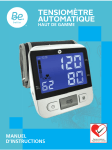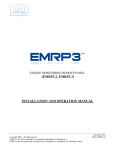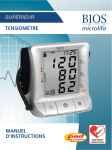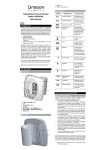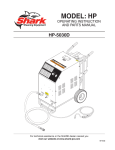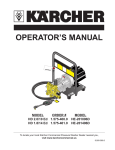Download BE PREMIUM PLUS BLOOD PRESSURE MONITOR Instruction manual
Transcript
PREMIUM PLUS BLOOD PRESSURE MONITOR UCTION INSTRUCTION MANUAL AL Recommended by Hypertension Canada Advanced Blood Pressure Monitor - Instruction Manual Table of contents 1. 1.1. 1.2. 2. 2.1. 2.2. 2.3. 3. 4. 4.1. 4.2. 4.3. 4.4. 4.5. 4.6. 5. 5.1. 5.2. 5.3. 5.4. 5.5. 5.6. 5.7. 5.8. 5.9. 5.10. 5.11. 6. 6.1. 7. 8. 9. 10. 11. Introduction Features of your blood pressure monitor Important information about self measurement Important Information on Blood Pressure and its Measurement How does high/low blood pressure arise? Which values are normal? What can be done if regular high/low values are obtained? Components of your Blood Pressure Monitor Using your Monitor for the First Time Installing the batteries Setting the date and time Cuff tube connection Select the measuring mode: Standard or Averaging Mode Select the user Averaging Mode Measurement Procedure Before measurement Common sources of error Fitting the cuff Measuring procedure PAD - Pulse Arrythmia Detection Traffic Light Indicator Memory - Displaying the last 120 measurements Discontinuing a measurement Setting the Medication Reminder Battery Indicator Using the AC Adapter Software Functions Installation and data transmission Error Messages/Troubleshooting Care and Maintenance Lifetime Warranty Certifications Technical Specifications 1 1. Introduction 1.1.Features of your Automatic Blood Pressure Monitor Your blood pressure monitor with Averaging Mode, Pulse Arrythmia Detection, and PC Link Blood Pressure Analyzer Software is a fully automatic digital blood pressure measuring device for use by adults on the upper arm at home or in your doctor’s/nurse’s office. It enables very fast and reliable measurement of systolic and diastolic blood pressure as well as pulse through the oscillometric method. This device offers clinically proven accuracy and has been designed to be user friendly. Before using, please read this instruction manual carefully and then keep it in a safe place. Please contact your doctor for further questions on the subject of blood pressure and its measurement. Attention! 1.2.Important information about self-measurement • Self-measurement means control, not diagnosis or treatment. Unusual values must always be discussed with your doctor. Under no circumstances should you alter the dosages of any drugs prescribed by your doctor. • The pulse display is not suitable for checking the frequency of heart pacemakers! • In cases of irregular heartbeat, measurements made with this instrument should only be evaluated after consultation with your doctor. Electromagnetic interference: The device contains sensitive electronic components. Avoid strong electrical or electromagnetic fields in the direct vicinity of the device (e.g. mobile telephones, microwave ovens). These can lead to temporary impairment of the measuring accuracy. 2. Important Information on Blood Pressure and its Measurement 2.1. How does high or low blood pressure arise? Your level of blood pressure is determined in the circulatory center of the brain and adjusts to a variety of situations through feedback from the nervous system. To adjust blood pressure, the strength and speed of the heart (Pulse), as well as the width of circulatory blood vessels is altered. Blood vessel width is controlled by fine muscles in the blood vessel walls. Your level of arterial blood pressure changes periodically during heart activity: During the “blood ejection” (Systole) the value is highest (systolic blood pressure value). At the end of the heart’s “rest period” (Diastole) pressure is lowest (diastolic blood pressure value). 2 Blood pressure values must lie within certain normal ranges in order to prevent particular diseases. 2.2. Which values are normal? Blood pressure is very high if your diastolic pressure is above 100 mmHg and/or your systolic blood pressure is over 160 mmHg, while at rest. In this case, please consult your physician immediately. Long-term values at this level endanger your health due to continual damage to the blood vessels in your body. If your systolic blood pressure values are between 140 mmHg and 159 mmHg and/or the diastolic blood pressure values between 90 mmHg and 99 mmHg, consult your physician. Regular self-checks are necessary. If you have blood pressure values that are too low, (i.e., systolic values under 105 mmHg and/or diastolic values under 60 mmHg), consult your physician. Even with normal blood pressure values, a regular self-check with your blood pressure monitor is recommended. You can detect possible changes in your values early and react appropriately. If you are undergoing medical treatment to control your blood pressure, keep a record of values along with time of day and date. Show these values to your physician. Never use the results of your measurements to independently alter the drug doses prescribed by your physician. Which values are normal? The following standards for assessing high blood pressure (without regard to age) have been established by the World Health Organization (WHO) in 2003. Category Optimal Normal High Normal Hypertension • Stage 1: Mild • Stage 2: Hypertension • Stage 3: Severe Isolated Systolic Hypertension Systolic (mmHg) <120 <130 130 - 139 140-159 160 - 179 >180 >140 Diastolic (mmHg) <80 <85 85 - 89 90-99 100 - 109 >110 <90 3 Further information • If your values are mostly normal under resting conditions but exceptionally high under conditions of physical or psychological stress, it is possible that you are suffering from so-called “labile hypertension.” Consult your doctor. • Correctly measured diastolic blood pressure values above 120 mmHg require immediate medical treatment. 2.3. What can be done if regular high or low values are obtained? a) Consult your doctor. b) Increased blood pressure values (various forms of hypertension) are associated with considerable health risks over time. Arterial blood vessels in your body are endangered due to constriction caused by deposits in the vessel walls (Arteriosclerosis). A deficient supply of blood to important organs (heart, brain, muscles) can result from arteriosclerosis. Furthermore, the heart will become structurally damaged with increased blood pressure values. c) There are many different causes of high blood pressure. We differentiate between the common primary (essential) hypertension, and secondary hypertension. The latter group can be ascribed to specific organ malfunctions. Please consult your doctor for information about the possible origins of your own increased blood pressure values. d) There are measures which you can take to reduce and even prevent high blood pressure. These measures must be permanent lifestyle changes. A) Eating habits • Strive for a normal weight corresponding to your age. See your doctor for your ideal weight. • Avoid excessive consumption of common salt. • Avoid fatty foods. B) Previous illnesses • Consistently follow all medical instructions for treating illness such as: • Diabetes (Diabetes mellitus or sugar diabetes) • Fat metabolism disorder • Gout C) Habits • Give up smoking completely. • Drink only moderate amounts of alcohol. • Restrict your caffeine consumption (coffee, tea, chocolate). 4 D) Your physical condition • After a medical examination, and with your doctor’s approval and direction; exercise. • Choose sports which require stamina and avoid those which require strength. • Avoid reaching the limit of your performance. • With previous illnesses and/or an age of over 40 years, please consult your doctor before beginning your exercise routine. Speak with your doctor regarding the type and extent of exercise that is appropriate for you. 3. Components of your blood pressure monitor a) Measuring unit Cuff Storage Mode Switch on side Select 1 or 3 Measurements AC Adapter Port Cuff Socket Memory Recall Button START/STOP Button Time/Date Button 5 b) Wide Range Cuff: For arm circumference 22 cm - 42 cm (8.7” - 16.5”) Please Note: Arm circumference should be measured with a measuring tape in the middle of the relaxed upper arm. Do not force cuff connection into the opening. Make sure the cuff connection is not pushed into the AC adapter port. 4. Using your Monitor for the First Time 4.1 Installing the batteries Insert batteries immediately after unpacking the unit. The battery compartment is located on the bottom of the device. a) Remove cover. b) Insert the batteries (4 x size AA 1,5V), observing the indicated polarity. c) If a battery warning appears in the display, the batteries are discharged and must be replaced. d) Do not mix old and new batteries. Do not mix alkaline, standard (carbon-zinc), or rechargeable (ni-cad, ni-mh, etc) batteries. 4.2 Setting the date and time 1. After the new batteries are activated, the year number flashes in the display. You can advance the year by pressing the "M" button. To confirm and then set the year, press the TIME button. 2. You can now set the month using the “M” button. To confirm and then set the month, press the TIME button. 3. Please follow the instructions above to set the day, hour and minutes. 4. Once you have set the last minute and pressed the TIME button, the date and time are set and the time is displayed. 5. If you want to change the date and time, press and hold the TIME button down for approx. 3 seconds until the user icon starts to flash, release the button and press again, the year number starts to flash. Now you can enter the new values as described above. 6 Memory Button Time/Date Button TIME PM 4.3. Cuff tube connection Insert the cuff tube into the opening on the side of the monitor indicated by the drawing. 4.4. Select the Measuring Mode: Standard or Averaging Mode This instrument enables you to select either Standard (single measurement) or Averaging Mode (automatic triple measurement). To select Standard mode, push the switch on the side of the instrument downward to Position "1“ and to select Averaging mode, upwards to Position “3”. If you select 1 then only one measurement will be taken. If you select 3, the unit will inflate and deflate three times resulting in one final average measurement. 1 3 4.5. Select the User This blood pressure monitor is designed to store 120 measurements for each of two users. In addition, there is a guest mode in which results are not stored. Before taking a measurement, be certain that the correct user has been selected. a) With the unit off, press and hold the TIME button for 3 seconds until the user icon in the upper left corner of the LCD screen flashes. b) Press the “M” button to toggle between user 1, user 2 and Guest mode. c) Press the START button to make your selection. 4.6. Averaging Mode Technology • In Averaging Mode, three measurements are automatically taken in succession and the result then automatically analyzed and displayed. Because your blood pressure constantly fluctuates, a result determined in this way is more reliable than one produced by a single measurement. • After pressing the START/STOP button the selected Averaging Mode appears in the display as the symbol. • The bottom, right hand section of the display shows a 1, 2 or 3 to indicate which of the 3 measurements is currently being taken. • There is a break of 15 seconds between the measurements (15 seconds are adequate according to “Blood Pressure Monitoring, 2001, 6:145-147” for oscillometric instruments). A countdown indicates the remaining time and a beep will sound 5 seconds before the 2nd and 3rd readings will begin. 7 • The individual results from measurements 1, 2 and 3 are not initially displayed. • If you want to see each of the individual readings making up a triplicate reading, press and hold the “M” button for 3 seconds immediately after an Averaging Mode measurement. Please note: You can only see the individual readings one time immediately following an Averaging Mode measurement. See section 5.4 G. • Do not remove the cuff between measurements. 5. Measurement Procedure Please note: You should always be seated before and during measurement. 5.1. Before Measurement: • Avoid eating and smoking as well as all forms of exertion directly before measurement. These factors influence the measurement result. Find time to relax by sitting in an armchair in a quiet atmosphere for about ten minutes before taking a measurement. • Remove any garment that fits closely to your upper arm. • Always measure on the same arm (normally left). • Always compare measurements taken at the same time of day, since blood pressure changes during the course of the day, as much as 20-40 mmHg. 5.2. Common Sources of Error: Note: Comparable blood pressure measurements always require the same conditions! Conditions should always be quiet. • All efforts by the user to support the arm can increase blood pressure. Make sure you are in a comfortable, relaxed position and do not flex any of the muscles in the measurement arm during the measurement. Use a cushion for support if necessary. • If the arm artery lies considerably lower or higher than the heart, an erroneously high or low blood pressure will be measured! Each 15cm (6 inch) difference in height between your heart and the cuff results in a measurement error of 10 mmHg! • Cuffs that are too narrow or too short result in false measurement values. Selecting the correct cuff is extremely important. Cuff size is dependent upon the circumference of the arm (measured in the center). The permissible range is printed on the cuff. • A loose cuff or a sideways protruding air pocket causes false measurement values. • With repeated measurements, blood accumulates in the arm, which can lead to false results. Consecutive blood pressure measurements should be repeated after a 1 minute pause or after your arm has been held up in order to allow the accumulated blood to flow away. If you decide to take your Averaging Mode measurement again, be sure to wait at least one minute beforehand. 8 5.3. Fitting the Cuff a) Remove tight or bulky clothing from your upper arm. b) Wrap the cuff around your upper left arm. The rubber tube should be on the inside of your arm extending downward to your hand. Make certain the cuff lies approximately 3/4” to 1” (2 to 3 cm) above the elbow. 3/4”-1” c) Tighten the cuff by pulling the end and close the cuff. d) There should be little free space between the arm and the cuff. You should be able to fit 2 fingers between your arm and the cuff. Clothing must not restrict the arm. Any piece of clothing which does, must be removed. Cuffs that don’t fit properly result in false measurement values. Measure your arm circumference if you are not sure of proper fit. e) Lay your arm on a table (palm upward) so the cuff is at the same height as your heart. Make sure the tube is not kinked. f) Remain seated quietly for at least two minutes before you begin the measurement. Comment: If it is not possible to fit the cuff to your left arm, it can also be placed on your right arm. However, all measurements should be made using the same arm. Comparable blood pressure measurements always require the same conditions (Relax for several minutes before taking a measurement). Cuff on right arm 9 5.4. Measuring Procedure After the cuff has been appropriately positioned on the arm and connected to the blood pressure monitor, the measurement can begin: Pumping Pressure a) Press the START/STOP button. The pump begins to inflate the cuff. In the display, the increasing cuff pressure is continually displayed. b) After automatically reaching an individual pressure, the pump stops and the pressure slowly falls. The cuff pressure is displayed during the measurement. Measuring c) When the device has detected your pulse, the heart symbol in the display begins to blink. d) When the measurement has been concluded, a long beep tone sounds. The measured systolic and diastolic blood pressure values, as well as the pulse are now displayed. e) The appearance of this symbol signifies that a pulse arrhythmia was detected. This indicator is only a caution. It is important that you be relaxed, remain still and do not talk during measurements. NOTE: We recommend contacting your physician if you see this indicator frequently. f) The measurement results are displayed until you switch the device off. If no button is pressed for 1 minute, the device switches off automatically. 10 Systolic Diastolic Pulse Measurement complete g) When the unit is set to the MAM (Averaging Mode) setting, 3 separate measurements will take place in succession after which your result is calculated and displayed as a single, averaged measurement. There is a 15 second resting time in-between each measurement. A countdown indicates the remaining time and a beep will sound 5 seconds before the 2nd and 3rd readings will begin. If one of the measurements causes an error message, it will be repeated one more time. If any additional error occurs, the measurement will be discontinued and error code displayed. Expanding the averaged measurement to see the three individual readings: this function allows you to view the three individual measurements used to calculate the Averaging Mode measurement. After taking an Averaging Mode measurement hold the “M” button for 3 seconds until you hear a short beep. (Do not hold the button longer than 7 seconds or you will delete all the readings in the memory.) Let go of the button and watch the screen. It will automatically scroll through the three measurements used in the measurement. 5.5. PAD - Pulse Arrhythmia Detection This symbol indicates that certain pulse irregularities were detected during the measurement. In this case, the result may deviate from your normal basal blood pressure – repeat the measurement. In most cases, this is no cause for concern. However, if the symbol appears on a regular basis (e.g. several times a week with measurements taken daily), we advise you to tell your doctor. Please show your doctor the following explanation: Information for the doctor on frequent appearance of the pulse arrhythmia symbol This instrument is an oscillometric blood pressure monitor device that also analyzes pulse frequency during measurement. The instrument is clinically tested. If pulse irregularities occur during measurement, the irregular heartbeat symbol is displayed after the measurement. If the symbol appears more frequently (e.g. several times per week on measurements performed daily) or if it suddenly appears more often than usual, we recommend the patient to seek medical advice. The instrument does not replace a cardiac examination, but serves to detect pulse irregularities at an early stage. 11 5.6. Traffic Light Indicator The bars on the left-hand edge of the display show you the range within which the indicated blood pressure value lies. Depending on the height of the bar, the readout value is either within the normal (green), borderline (yellow) or danger (red) range. The classification is based on standards established by the World Health Organization. Refer to the chart below for details of the classification. SYS (mmHg) DIA 180 110 160-180 100-110 Red Red Orange 140-160 130-140 120-130 120 Yellow Green Green 90-100 85-90 80-85 80 WHO World Health Organization 2003 The traffic light bar raises according to your measurement. • If your measurement has only one or two bars, your measurement is in the green zone, or “Normal” according to the WHO classification. • If your measurement has three bars, it is in the yellow zone, or “high normal” according to the WHO classification. • If your measurement has four bars, it is in the orange “Stage 1 Hypertension” zone. • If your measurement has five or more bars, it is in the red “Stage 2 Hypertension” zone. • If your measurement has six bars, it is in the red “Stage 3 Hypertension” zone. Indication of a “Optimum” Blood Pressure 12 Indication of a “Normal” Blood Pressure Indication of “PreHypertension” Blood Pressure Red Red Red Red Red Orange Yellow Orange Yellow Orange Yellow Green Green Green Green Green Green Red Indication of a “Stage 1 Hypertension” Blood Pressure Indication of a “Stage 2 Hypertension” Blood Pressure Indication of a “Stage 3 Hypertension” Blood Pressure Red Red Red Red Red Red Orange Yellow Orange Yellow Orange Yellow Green Green Green Green Green Green 5.7. Memory – Displaying the last 120 Measurements At the end of a measurement, this monitor automatically stores each result with date and time. This unit stores 120 memories for each of 2 users. Viewing the stored values With the unit off, press the "M" button. The display first shows "A", then shows an average of all measurements stored in the unit. Please note: Measurements for each user are averaged and stored separately. Be certain that you are viewing the measurements for the correct user. Pressing the "M" button again displays the previous value. To view a particular stored memory, press and hold the “M” button to scroll to that stored reading. Memory full When the memory has stored 120 results a new measured value is stored by overwriting the oldest value. Clear all values If you are sure that you want to permanently remove all stored values, hold down the "M" button (the instrument must have been switched off beforehand) until "CL" appears and then release the button. If you do not want to clear the values, press the START/STOP button. To permanently clear the memory, press the "M" button while "CL" is flashing. Individual values cannot be cleared. 13 5.8. Discontinuing a Measurement If it is necessary to interrupt a blood pressure measurement for any reason (e.g the patient feels unwell), the START/STOP button can be pressed at any time. The device then immediately lowers the cuff pressure automatically. 5.9. Setting the Medication Reminder This instrument allows you to set two alarm times at which an alarm signal will then be triggered. This can be a useful aid, for instance as a reminder to take medication or to remind you to take your blood pressure at the same time each day. 1. To set an alarm time, press the TIME button (the instrument must have been switched off beforehand) and immediately afterwards the "M" button and hold both down until the bell symbol appears in the bottom left of the display. Then release both buttons. The flashing "1" in the display indicates that the first alarm time can now be set. 2. Press the TIME button to set the hours – the hours display flashes and pressing the "M" button allows you to set the alarm hour. To confirm, press the TIME button. 3. The minute display will now flash. The minutes can be set using the "M" button. To confirm, press the TIME button again. 4. The bell symbol will now flash. Use the "M" button to select whether the alarm time is to be active (bell) or inactive (crossedout bell). To confirm, press the TIME button. To set a second alarm time, proceed as above but if the "1" flashes, press the "M" button to select "2" and confirm with the TIME button. • An active alarm time is indicated by the bell symbol in the display. • The alarm sounds at the set time every day. • To switch-off the alarm when it is sounding, press the START/STOP button. • To permanently switch-off the alarm, proceed as above (steps 1-4) and select the crossed-out bell symbol. This will then disappear from the display. • The alarm times must be re-entered each time the batteries are replaced. 14 TIME PM 5.10. Battery Indicator Batteries almost discharged When the batteries are approximately 75% used the battery symbol will flash as soon as the instrument is switched on (if at least one of the batteries still has some charge). Although the instrument will continue to measure reliably, you should obtain replacement batteries. Batteries discharged– replacements required When the batteries are discharged, the battery symbol will flash as soon as the instrument is switched on. You cannot take any further measurements and must replace the batteries. 1. Open the battery compartment at the back of the instrument. 2. Replace the batteries – ensure they are correctly connected, as shown on the symbols in the compartment. 3. The memory retains all values although date and time must be reset - the year number therefore flashes automatically after the batteries are replaced. 4. To set date and time, follow the procedure described in Section 4.2. Which batteries and which procedure? Use four new, longlife 1.5V AA batteries. Do not use batteries beyond their expiration date. If the monitor is not going to be used for a prolonged period the batteries should be removed. Do not mix new and old batteries. Using rechargeable batteries You can also operate this instrument using rechargeable batteries. • Please use only type "NiMH" reusable batteries! • If the battery symbol ( ) appears, the batteries must be removed and recharged! They must not remain inside the instrument, as they may become damaged through total discharge even when switched off. The batteries must NOT be discharged in the blood pressure monitor! If you do not intend to use the instrument for a week or more, always remove the rechargeable batteries! • Recharge these batteries using an external charger and follow manufacturer’s instructions carefully. 15 5.11. Using the AC Adapter You may also operate this monitor using the included AC Adapter (output 6V DC/600 mA with DIN plug). Use only the included AC Adapter to avoid damaging the unit. 1. Ensure that the AC adapter and cable are not damaged. 2. Plug the adapter cable into the AC Adapter port on the blood pressure monitor. 3. Plug the adapter into your electrical outlet. When the AC adapter is connected, no battery current is consumed. Note: No power is taken from the batteries while the AC Adapter is connected to the monitor. If electrical power is interrupted, (e.g., by accidental removal of the AC adapter from the outlet) the monitor must be reset by removing the plug from the socket and reinserting the AC adapter connection. 6. Software Functions This unit can be used in connection with your personal computer (PC) running the PC Link Blood Pressure Analyzer software. Your PC will allow a capacity of monitoring 80 patients, each with 1000 data (note: overuse will lower system efficiency). The memory data can be transferred to the PC by connecting the monitor via the included USB cable with your PC. Note: The software does not work with Mac computers. 6.1. Installation and Data Transmission a) Insert CD into CD ROM drive of your PC. The installation will start automatically. If not, click on SETUP.EXE. b) Connect the monitor via USB cable with the PC. Three horizontal bars will appear on the display and last for 3 seconds. c) The bars will then flash to indicate that the connection between computer and device is successfully made. As long as the cable is plugged in, the bars will keep flashing and the buttons are disabled. During the connection, the device is completely controlled by the computer. 16 19 7. Error Messages/Troubleshooting If an error occurs during a measurement, the measurement is discontinued and a corresponding error code is displayed. We recommend you switch the device off and take a new measurement making sure you allow time for relaxation (example: error no. 1). Error No. ERR 1 ERR 2 ERR 3 ERR 5 HI LO Possible cause(s) / Solutions The tube may have loosened, or no pulse was detected. *Ensure cuff connections are tight with proper cuff placement. See section (5.3) Unnatural pressure impulses. Reason: The arm was moved during the measurement (Artifact). Repeat measurement keeping arm still. Repeat measurement keeping arm still. If inflation of the cuff takes too long, the cuff is not correctly seated or the hose connection’s not tight. Check connections and repeat. The difference between systolic and diastolic is excessive. Measure again carefully following proper cuff procedures and ensure measurement under quiet conditions. The cuff pressure is too high. Relax for 5 minutes and repeat the measurement.* The pulse is too low (less than 40). Repeat the measurement.* *If this or any other problem occurs repeatedly, please consult your doctor. 20 17 Other possible errors and their solutions If problems occur when using the device, the following points should be checked: Malfunction Remedy The display remains blank when the instrument • Check battery installation or AC adapter conis switched on although the batteries are in nection is correct and wall outlet is working. place. • If the display is unusual, remove the batteries and then exchange them for new ones. Check polarity. The pressure does not rise although the pump • Check the connection of the cuff tube and connect properly. is running. 1. Ensure the cuff fits properly. (see 5.3) The device frequently fails to measure, 2. Before starting measurement make sure or the values measured are too low or high. that the cuff is not too tight and that clothing is not exerting pressure on the arm. Take articles of clothing off if necessary. 3. Measure blood pressure again in complete peace and quiet. Every measurement results in different values, • Please read the following information and the points listed under “Common sources of although the device functions normally and error”.(5.2) Repeat the measurement. normal values are displayed. • Blood pressure changes constantly. The observed readings may accurately reflect your pressure. Blood pressure values differ from those meas- • Record daily values and consult your doctor. • Pressure readings in your doctor’s office may ured by my doctor. be higher due to anxiety. • Check cuff connections. After the instrument has inflated the cuff the Ensure the unit has not been tampered with. pressure falls very slowly, or not at all. (No reasonable measurement possible). 18 21 8. Care and Maintenance a) Do not expose the device to either extreme temperatures, humidity, dust or direct sunlight. b) The cuff contains a sensitive air-tight bubble. Handle this cuff carefully and avoid all types of stress through twisting or buckling. c) Clean the device with a soft, dry cloth. Do not use gas, thinners or similar solvents. Spots on the cuff can be removed carefully with a damp cloth and soapsuds. The cuff with bladder must not be washed in a dishwasher, clothes washer, or submerged in water. d) Handle the tube carefully. Do not pull on it. Do not allow the tubing to kink and keep it away from sharp edges. e) Do not drop the monitor or treat it roughly in any way. Avoid strong vibrations. f) Never open the monitor! This invalidates the manufacturer’s warranty. g) Batteries and electronic instruments must be disposed of in accordance with the locally applicable regulations, not with domestic waste. h) Do not mix new and old batteries. 22 19 9. Lifetime Warranty Be Better™ blood pressure monitors have a lifetime warranty to be free of manufacturing defects for the life of the original owner. This warranty does not include the inflation system including the cuff and inflation bladder. The cuff is warranted for two years. The warranty does not cover damage from misuse or tampering. If you have questions regarding the operation of your monitor call the Blood Pressure Hotline: 1-866-536-2289 Should repair be necessary, return the unit with all component pieces. Enclose proof of purchase and $5.00 for return shipping and insurance. Ship the unit prepaid and insured (at owners option) to: Thermor Ltd. Repair Department 16975 Leslie Street Newmarket, ON L3Y 9A1 [email protected] Please include your name, return address, phone number, and email address. Thermor will repair or replace (at Thermor’s option) free of charge any parts necessary to correct the defect in material or workmanship. Please allow 10 days for repair and return shipping. 20 23 10. Certifications Device standard: Electromagnetic compatibility: Device corresponds to the requirements of the standard for non-invasive blood pressuresure monitors: AAMI/ANSI SP10 IEC 60601-1 IEC 60601-1-2 Device fulfills the stipulations of the International standard IEC 60601-1-2 The B.H.S. (British Hypertension Society) has graded this product A/A or “Recommended for clinical and home use.” This is the highest grading available for blood pressure monitors. Please see the B.H.S. website at www.bhsoc.org. *Product using the identical measurement algorithm was tested by unaffiliated researchers using B.H.S. study protocol. Results on file and available upon request. 11. Technical Specifications: Weight: Size: Storage temperature: Humidity: Operation temperature: Display: Measuring method: Pressure sensor: Measuring range: SYS/DIA: Pulse: Cuff pressure display range: Memory: Measuring resolution: Accuracy: Power source: Accessories: 735 g (with batteries) 160 (W) x 140 (L) x 98 (H) mm –20°C to +55°C (-4°F to +131°F) 15 to 90% relative humidity maximum 10°C to 40°C (50°F - 104°F) LCD-Display (Liquid Crystal Display) oscillometric capacitive 30 to 280 mmHg 40 to 200 per minute 0–299 mmHg Automatically stores the last 120 measurements for 2 users (total 240) 1 mmHg pressure within ± 3 mmHg or 2 % of the reading > 200mmHg pulse ± 5 % of the reading a) 4 AA batteries, 1.5 V b) AC adapter 6 V DC 600 mA (voltage 4.5 V DC to 6 V DC) wide range rigid cuff 22-42cm (8.7” - 16.5”) Technical alterations reserved! *Not for use on children 12 years of age or younger. Read the instructions carefully before using this device. TH1918_040511 21
























